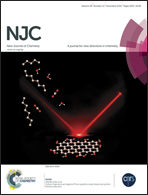Synthesis, characterization, photophysics, and anion binding properties of gold(i) acetylide complexes with amide groups†
Abstract
A series of mononuclear gold(I) acetylide complexes with amide groups, Ph3PAuC![[triple bond, length as m-dash]](https://www.rsc.org/images/entities/char_e002.gif) CC6H4NHC(O)C6H4–R-4 (R = NO2 (3a), CF3 (3b), H (3c), and OMe (3d)), has been synthesized and characterized. The crystal structure of Ph3PAuC
CC6H4NHC(O)C6H4–R-4 (R = NO2 (3a), CF3 (3b), H (3c), and OMe (3d)), has been synthesized and characterized. The crystal structure of Ph3PAuC![[triple bond, length as m-dash]](https://www.rsc.org/images/entities/char_e002.gif) CC6H4NHC(O)C6H4–NO2-4 (3a) was determined by X-ray diffraction. The photophysical properties of gold(I) acetylide complexes 3b–3d were studied and the complexes show luminescence both in the solid state and in degassed THF solutions at 298 K. The anion-binding abilities of complexes 3a–3d in CDCl3 were also studied through 1H NMR titration experiments. They show similar anion selectivity trends and 3a exhibits the highest binding affinity towards anions due to the strongest electron-withdrawing ability of the NO2 group. In DMSO, 3a shows a dramatic color change upon addition of F−, which provides access to naked eye detection of F−.
CC6H4NHC(O)C6H4–NO2-4 (3a) was determined by X-ray diffraction. The photophysical properties of gold(I) acetylide complexes 3b–3d were studied and the complexes show luminescence both in the solid state and in degassed THF solutions at 298 K. The anion-binding abilities of complexes 3a–3d in CDCl3 were also studied through 1H NMR titration experiments. They show similar anion selectivity trends and 3a exhibits the highest binding affinity towards anions due to the strongest electron-withdrawing ability of the NO2 group. In DMSO, 3a shows a dramatic color change upon addition of F−, which provides access to naked eye detection of F−.


 Please wait while we load your content...
Please wait while we load your content...